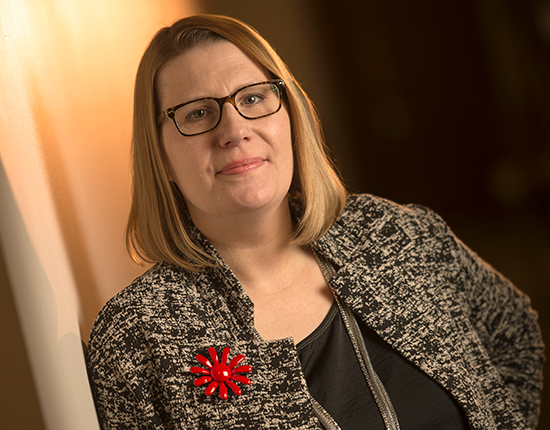
Sept. 2, 2020 – Despite the global pandemic, Karen Bauer’s financial outlook vastly improved this summer. The balance of her law school student loans was forgiven. She became a beneficiary of the federal Public Service Loan Forgiveness (PSLF) program.
The PSLF program forgives student loan debt for those who work in public service jobs for 10 years. Bauer has worked as a public-interest lawyer since graduating in 2009, first for Wisconsin Judicare and now for the Legal Aid Society of Milwaukee.
Public-interest workers like Bauer may forego higher paying jobs for the promise of debt relief, a calculated decision as today’s student loan debts can reach into the six figures. Now, she will continue her career without the added stress of a large student loan debt.
“I was overjoyed to see my loans were finally forgiven,” said Bauer, who has taught continuing legal education courses on student loans for years. “After over a decade working as a public-interest lawyer, I felt like my time had finally come.”
But Bauer is one of a small percentage of public service workers who have actually received PSLF forgiveness – largely because they have failed to show they meet all eligibility requirements. Meanwhile, student loan debt in America continues to rise and remains a major political talking point in this current election cycle.
Bauer was a member of Gov. Tony Evers’ Task Force on Student Debt, which recently issued a final report noting that Wisconsin has more than $24 billion in outstanding student loan debt. In the U.S., 45 million students owe approximately $1.7 trillion.
The student loan debt crisis directly affects the legal profession, as law students begin careers with significant balances and access to a legal education is increasingly out of reach for others with aspirations in law. It also affects the practice of law because more lawyers will be called on to help navigate educational debt problems, and find solutions.
“Lawyers should all familiarize themselves with how student loan repayment works, and the various loan forgiveness and debt mitigation options,” Bauer said. “With millions of student loan debtors out there, that debt can affect many different issues lawyers deal with – from estate planning, to retirement planning, and of course, bankruptcy.”
Borrowing More
Since the 1980s, tuition rates in current dollars have increased about 500 percent at four-year public and private universities. As of 2016, the average student debt of college seniors who borrowed was almost $30,000, compared to $12,750 in 1996.
 Joe Forward, Saint Louis Univ. School of Law 2010, is a legal writer for the State Bar of Wisconsin, Madison. He can be reached by email or by phone at (608) 250-6161.
Joe Forward, Saint Louis Univ. School of Law 2010, is a legal writer for the State Bar of Wisconsin, Madison. He can be reached by email or by phone at (608) 250-6161.
Those borrowing for advanced degrees, such as law students, will often graduate with much larger debt loads, and with a repayment outlook of 20 years or more. Many borrowers will still be paying their student loans as their children prepare for college.
According to the American Bar Association (ABA), in 1985, the average annual tuition for a resident at a public law school was just over $2,000, $4,724 for private schools.
Today, tuition at Marquette University School of Law is $48,980 per year. That does not include costs for books, housing, food, and transportation. Tuition at U.W. Law School is $27,704 ($46,400 nonresident), again, not including books and living expenses.
Thus, a law school student (and other students) may calculate a year’s worth of living expenses, in addition to tuition, in determining how much to borrow. Of course, working can help students defray the costs involved, but law school is already a full-time job.
Finding Solutions
State and federal governments are exploring more ways to reduce student loan debt burdens, although loan forgiveness programs and other student loan-related laws that affect taxpayer dollars must wind their way through legislative houses.
In its final report, Wisconsin’s Task Force on Student Debt submitted eight recommendations to help address the student loan debt problem.
For instance, the task force recommends expanding or creating more loan forgiveness programs to help more borrowers. Wisconsin already maintains state loan forgiveness programs for physicians and teachers who work in low-income and shortage areas.
The task force recommends an exploration of how those existing programs could be expanded, or target other fields or areas to support through loan forgiveness.
“In order for Wisconsin to attract and retain talent across a variety of professions, we need to offer programs for student debt forgiveness that are as good, if not better than those in other states,” said Bauer.
“These types of programs are not only effective in preventing ‘brain drain’ from the state – they are cost effective. Student loan forgiveness can help organizations avoid the high cost of recruitment and training of new employees, if they are dealing with high turnover into other sectors or other locations that pay more.”
The State Bar of Wisconsin supports legislative efforts to reduce the cost of legal education and to provide loan repayment assistance programs where appropriate.

“Lawyers should all familiarize themselves with how student loan repayment works, and the various loan forgiveness and debt mitigation options,” says Karen Bauer, a member of Gov. Tony Evers’ Task Force on Student Debt, which recently issued a final report noting that Wisconsin has more than $24 billion in outstanding student loan debt. In the U.S., 45 million students owe approximately $1.7 trillion.
In 2017, the State Bar supported a bill that that would have established a pilot program to give private bar attorneys who accept at least 50 public defender appointments per year in rural counties up to $20,000 per year to pay law school debt. It failed to pass.
The task force also recommends more tax credits for borrowers and creation of a state refinancing program allowing borrowers to refinance their loans at lower interest rates if they do not otherwise qualify for refinancing through other market-based options.
The interest rate on direct loans through the U.S. Department of Education fluctuates yearly in line with Treasury bill rates and cannot generally exceed 8 percent.
To support low-income and underrepresented students, the task force recommends increased aid through grant programs that will expand access to higher education.
“If Wisconsin doesn’t act to help ensure that higher education is attainable for everyone, we will hinder future economic growth and development,” Bauer said.
She said supporting low-income and underrepresented students to get an education means that we are ensuring a bright future for every Wisconsinite.
“The Task Force studied the effects of high student debt on Black and other underrepresented students,” Bauer noted. “When families do not have intergenerational wealth to afford helping with higher education costs, it makes it impossible to build more wealth, and we end up with swaths of our population stuck in a cycle of poverty.”
PSLF is a Current Option
The PSLF program was created as part of the bipartisan College Cost Reduction and Access Act (CCRAA) – signed by President George W. Bush in 2007 – to encourage a larger portion of the U.S. labor force to take government and other public service jobs.
But few have been as fortunate as Bauer, a lawyer who leaned on her legal training to learn the law’s numerous requirements while navigating the repayment system.
As of June 2020 – three years after the first cohort of graduates became eligible to receive PSLF forgiveness after 10 years of public service work – more than 207,000 individuals have submitted an application for loan forgiveness discharge.
Only 2,860 (1.4 percent) have received the discharge. Almost 16,000 applications are still pending, but more than 187,000 applications had been deemed ineligible.
Almost 60 percent were deemed ineligible because the applicant did not make qualifying payments, 24 percent of ineligible applications had missing information, and 14 percent did not have loans that qualified for forgiveness under the PSLF program.
“I started studying the CCRAA when it was originally proposed and spent many hours learning about the law and its many requirements,” Bauer said.
“And even I encountered some issues along the way with misinformation from my servicer, and uncounted payments. While lawyers should not have to be involved in order for someone to access the benefits of PSLF, the complexity of the law involved means that an attorney’s skill set can be very useful in navigating it all.”
The PSLF program requires the applicant to have qualifying employment, qualifying loans, and qualifying payments. For instance, federal Direct and Direct Consolidated loans qualify, but Federal Family Education Loans do not.
A “qualified payment” is one made under a “qualified repayment plan.” While payments made under income-driven repayment plans count, payments made under graduated, extended, or alternative repayment plans do not count.
Income-driven repayment plans calculate monthly repayment amounts as a percentage of income. The repayment amount may not be enough to cover interest that accrues each month. Thus, depending on the interest rate, balances will increase over time.
Only “public service organizations” – government organizations, 501(c)(3) nonprofits, and other private nonprofits that provide certain services are qualified employers.
The U.S. Department of Education has tinkered with eligibility standards and what it means to be a “public service organization,” which prompted litigation and a favorable outcome for lawyers providing “public-interest legal services” at the ABA.
Other lawsuits have alleged student loan servicers misguided or misdirected borrowers who may have been eligible for the PSLF but were not counseled about it.
Borrowers can annually submit an “employer certification form” to obtain a determination on whether an employer is considered a “qualifying employer.”
Wisconsin’s public defenders, prosecutors, and nonprofit legal aid lawyers should all qualify for PSLF – since they are government employees or work for qualifying nonprofits – as do attorneys working in the court system or other government jobs.
But they must stay in “qualified” employment for 10 years, and make 120 qualifying monthly payments. Even one late payment can dismount a PSLF candidate, who must closely study the requirements and monitor the situation to ensure eligibility.
“Learning the applicable regulations and completing Employment Certification Forms regularly to make sure you are on track for forgiveness is definitely the key to PSLF success,” Bauer said. “The information is available, but it definitely requires a time commitment to understand the rules.”
Repayment Relief During COVID-19
As Elizabeth Groeschel noted in the State Bar of Wisconsin Public Interest Law Section Blog, the Coronavirus Aid, Relief, and Economic Security (CARES) Act, provides temporary relief to student loan borrowers through Sept. 30, 2020.
The relief includes a suspension of payments with zero interest, and non-payments will still count as a qualified payment for those on track for PSLF forgiveness.
Samantha Bastil provided a recent update on that front, in the Public Interest Law Section Blog, noting President Donald Trump, by executive order, has extended student loan relief through the end of the year. But as Bastil notes, Congress could potentially alter the executive order by enacting another coronavirus aid bill or other legislation.
Conclusion
As another academic year begins, lawyers and law students should understand the student debt relief options available to guide personal financial decisions and to provide counsel to clients with student loan debt. The recommendations from the Governor’s Task Force on Student Debt may be a guide for additional relief programs in the future.
